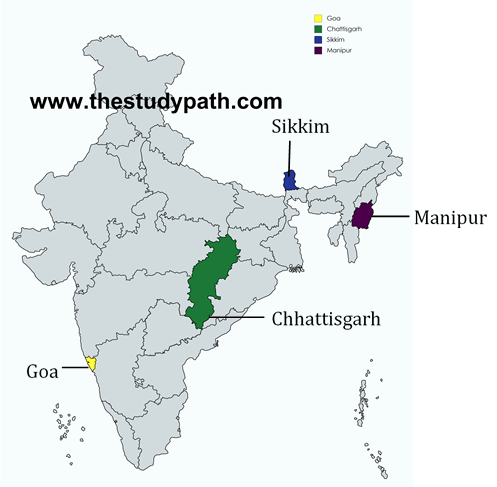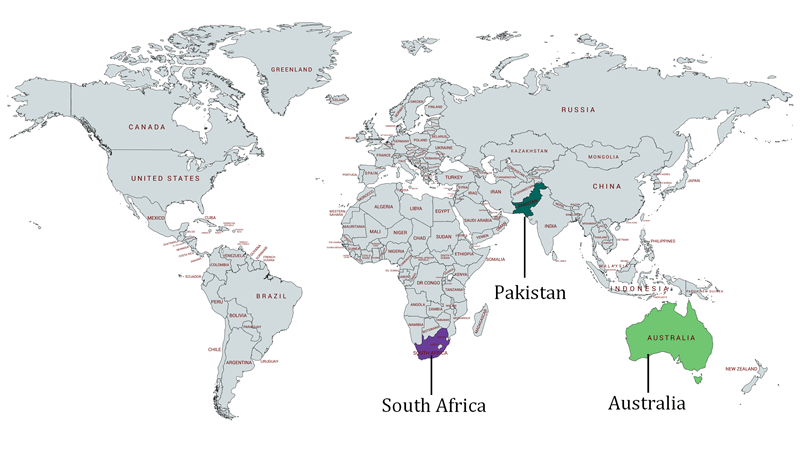NCERT Solutions for Class 10 Social Science Civics (Political Science) Chapter 2 Federalism help students to score good marks in the exams. These NCERT Solutions are prepared by expert teachers based on the latest pattern of the NCERT book. Here we have provided answers to all the questions in a very easy language so that you can understand them easily.
Class 10 Civics Chapter 2 Federalism Questions and Answers
Question 1: Locate the following States on a blank outline political map of India: Manipur, Sikkim, Chhattisgarh and Goa
Answer:

Question 2: Identify and shade three federal countries (other than India) on a blank outline political map of the world.
Answer:

Question 3: Point out one feature in the practice of federalism in India that is similar to and one feature that is different from that of Belgium.
Answer:
Similarity: Both India and Belgium practice a form of federalism where powers are divided between the central government and various regional governments.
Difference: In Belgium, regional divisions are primarily based on linguistic and cultural differences, while in India, they are based on a combination of linguistic, cultural, historical, and administrative factors.
Question 4: What is the main difference between a federal form of government and a unitary one? Explain with an example.
Answer: In a federal system, there are two levels of government – a central or national government and regional or state governments. Each level of government has its own set of powers and responsibilities outlined in the constitution. For example, in India, power is divided between the government at the Centre and the various State governments.
A unitary government places all powers and authority in a single central government. Local or regional governments, if they exist, derive their powers from the central government and can be altered or abolished by it. For example, the United Kingdom operates under a unitary system where the central government in Westminster has complete authority, and local governments like those in Scotland and Wales derive their powers from the UK Parliament.
Question 5: State any two differences between the local government before and after the constitutional amendment in 1992.
Answer:
| Local governments BEFORE the Constitutional amendment in 1992 | Local governments AFTER the Constitutional amendment in 1992 |
| Elections were not held regularly | It is mandatory to hold regular elections to local government bodies |
| Local governments did not have any powers or resources of their own. | The State governments are required to share some powers and revenue with local government bodies |
Question 6: Fill in the blanks:
Answer: Since the United States is a coming together type of federation, all the constituent States have equal powers and States are strong vis-à-vis the federal government. But India is a holding together type of federation and some States have more power than others. In India, the Central government has more powers.
Question 7: Here are three reactions to the language policy followed in India. Give an argument and an example to support any of these positions.
Sangeeta: The policy of accommodation has strengthened national unity.
Arman: Language-based States have divided us by making everyone conscious of their language.
Harish: This policy has only helped to consolidate the dominance of English over all other languages.
Answer: Position: Sangeeta’s view that the policy of accommodation has strengthened national unity.
Argument: The policy of accommodation in India, where multiple languages are recognized and supported, has indeed strengthened national unity. It acknowledges the linguistic and cultural diversity of the country and ensures that people can communicate and access government services in their preferred languages, fostering inclusivity and harmony.
Example: India’s multilingual approach can be seen in the Eighth Schedule of the Indian Constitution, which recognizes 22 officially recognized languages, including Hindi, Bengali, Tamil, and others.
Question 8: The distinguishing feature of a federal government is:
a) National government gives some powers to the provincial governments.
b) Power is distributed among the legislature, executive and judiciary.
c) Elected officials exercise supreme power in the government.
d) Governmental power is divided between different levels of government.
Answer: (d) Governmental power is divided between different levels of government.
Question 9: A few subjects in various Lists of the Indian Constitution are given here. Group them under the Union, State and Concurrent Lists as provided in the table below.
A. Defence
B. Police
C. Agriculture
D. Education
E. Banking
F. Forests
G. Communications
H. TradeMarriages
| Union List | |
| State List | |
| Concurrent List |
Answer:
| Union List | Defence, Baking, Communication |
| State List | Police, Agriculture, Trade |
| Concurrent List | Education, forests, Marriages |
Question 10: Examine the following pairs that give the level of government in India and the powers of the government at that level to make laws on the subjects mentioned against each. Which of the following pairs is not correctly matched?
| (a) State government | State List |
| (b) Central government | Union List |
| (c) Central and state government | Concurrent List |
| (d) local governments | Residuary Powers |
Answer:
| (d) local governments | Residuary Powers |
Question 11: Match List I with List II and select the correct answer using the codes given below the lists:
| List I | List II |
| 1. Union of India | A. Prime Minister |
| 2. State | B. Sarpanch |
| 3. Municipal Corporation | C. Governor |
| 4. Gram Panchayat | D. Mayor |
| 1 | 2 | 3 | 4 | |
| (a) | D | A | B | C |
| (b) | B | C | D | A |
| (c) | B | D | A | C |
| (d) | C | D | A | B |
Answer:
| 1 | 2 | 3 | 4 | |
| (c) | A | C | D | B |
Question 12: Consider the following statements.
(a) In a federation, the powers of the federal and provincial governments are clearly demarcated.
(b) India is a federation because the powers of the Union and State Governments are specified in the Constitution and they have exclusive jurisdiction on their respective subjects.
(c) Sri Lanka is a federation because the country is divided into provinces.
(d) India is no longer a federation because some powers of the states have been devolved to the local government bodies.
Which of the statements given above are correct?
(a) A, B and C
(b) A, C and D
(c) A and B only
(d) B and C only
Answer: (c) A and B only
More study materials for CBSE Class 10
| NCERT Solutions for Class 10 | CBSE Notes for Class 10 |
| CBSE Sample Papers for Class 10 | Important Questions for Class 10 |
| RS Aggarwal Solutions For Class 10 | RD Sharma Solutions For Class 10 |